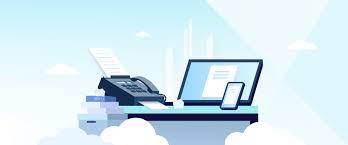The History of Fax Technology
The inception of fax technology marked a monumental leap in how information was shared across distances. The fax machine’s evolution continued with significant progressions, such as the wireless transmission of documents over radio waves, and later, each leap improved upon the last. This machinery was instrumental in expediting communications, particularly during World War II, emphasizing the necessity and utility of instantaneous document transmission in critical times. From government offices to newsrooms, faxing became an indispensable tool and an enduring symbol of rapid communication.
Modern Fax Solutions and Cloud Services
In this digital realm, the bulky, noise-emitting fax machines have given way to a sleeker, more convenient transmission mode of cloud fax services. Flourishing in the new digital environment, these services, which can be found through simple searches for free fax services near me, provide the flexibility to send and receive faxes via email, significantly minimizing the office footprint of conventional fax machines. Such services offer myriad advantages, including, but not limited to, cutting down on machine maintenance, mitigating the risks of hardware malfunction, and substantially reducing overhead costs. Most importantly, these cloud-based platforms are often baked with robust security features that cater to modern businesses’ growing demand for security in document transmission.
While email and other digital communication modes have become ubiquitous, they sometimes must meet stringent security and compliance requirements. Cloud fax services fill this gap, often offering end-to-end encryption and adhering to compliance standards like HIPAA for healthcare, ensuring sensitive documents retain their integrity from sender to receiver. This fax modernization has kept it relevant and rejuvenated it as a trusted mechanism in the digital age.
The Role of Fax in Today’s Business Environment
Today, faxing remains essential in many business segments, defying the odds presented by rapidly advancing communication technologies. For instance, in the healthcare sector, faxes are still the standard for transmitting patient records and prescriptions due to unparalleled privacy and confirmation of receipt. Similarly, in legal arenas, the ability for faxes to act as legally binding documents has cemented their place in the transmission of contracts and sensitive case information. The tangible nature of fax, aligned with the tradition of physical signatures, adds a level of solemnity and legality that electronic methods have yet to replicate fully. Despite advances in digital security, the legal precedent and established trust in fax technology render it an immovable piece in the arsenal of business communication tools.
Why Fax Technology Still Matters for Security and Privacy
The stronghold of fax technology in secure communication is primarily attributed to its track record of keeping intercepted access to a minimum. Compared to emails that may traverse through multiple servers and are susceptible to hacking, faxes historically transmitted over telephone lines pose a more challenging target for digital eavesdroppers. The digitization of fax has brought advanced encryption technologies, further solidifying its position as a secure means of exchanging documents. Enterprises handling sensitive data (legal documents, confidential business plans, or health records)often opt for fax for its reduced vulnerability to cybersecurity threats.
Regulatory bodies across various industries consistently mandate stringent data protection mechanisms, and modern digital fax services have risen to meet these standards. They’ve incorporated sophisticated security measures, including robust encryption protocols and secure storage, ensuring that documents remain confidential and intact throughout their digital journey. As privacy concerns continue escalating, the appeal of fax technology, with its robust security measures, remains indisputable.
Comparing Fax Services: What to Look for in a Provider
Finding a fax service that aligns with your organization’s needs is an investment into the integrity and fluidity of your interoffice communications. When weighing options, seek out service providers who prioritize features that streamline operations, user-friendly interfaces, compatibility with a range of devices, and proactive customer support can significantly influence your team’s efficiency levels. Additionally, cost considerations can weigh heavily; finding a service offering transparent pricing without hidden fees for features like international faxing or additional users is prudent.
Perhaps most crucially, the security credentials of fax services should undergo rigorous scrutiny. Data privacy compliance, end-to-end encryption, and reliable delivery confirmations are non-negotiable elements in maintaining the sanctity of sensitive communications. Integrating fax communications with existing systems can add significant value by seamlessly weaving it into daily business processes. These attributes distinguish a merely functional service from one that becomes a key asset to your workflow efficiency.
Integrating Fax with Other Business Systems
The value of fax technology multiplies significantly when it harmonizes with a company’s existing tech stack. The integration capability of a fax service is a key differentiator, which makes it essential to consider. Direct fax-to-email services and integration with cloud storage solutions simplify document exchange. This symbiotic interaction expedites processes, ensuring incoming faxes can feed directly into client profiles or project files without manual intervention.
Service integrations have the potential to significantly reduce administrative labor, conserving resources for more strategic business endeavors. By establishing a streamlined communication ecosystem, integrated fax solutions can provide a pathway for businesses to optimize operations, save time, and, ultimately, put the focus back on what truly matters: their core mission and client satisfaction.
